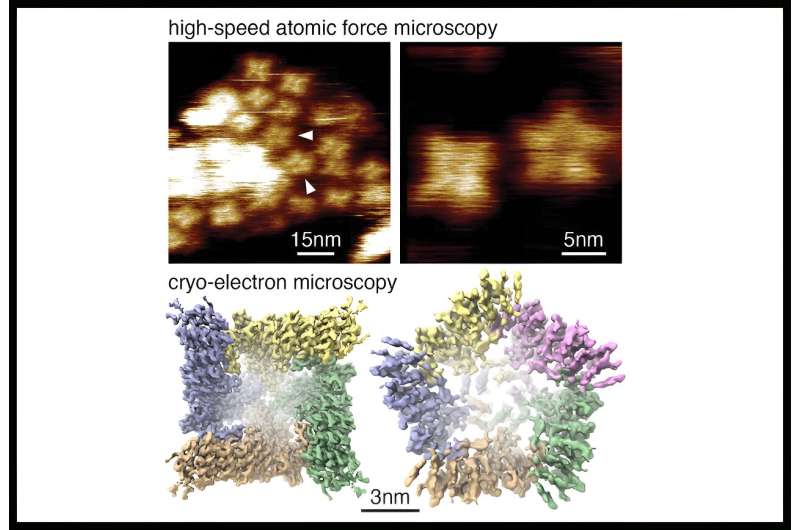This article has been reviewed according to Science X's editorial process and policies. Editors have highlighted the following attributes while ensuring the content's credibility:
fact-checked
peer-reviewed publication
trusted source
proofread
Study finds how some ion channels form structures permitting drug delivery

A member of an important class of ion channel proteins can transiently rearrange itself into a larger structure with dramatically altered properties, according to a study led by researchers at Weill Cornell Medicine. The discovery is a significant advance in cell biology, likely solves a long-standing mystery about an unusual feature of some ion channels and has implications for the development of drugs targeting these proteins and for drug delivery.
Ion channels are ubiquitous in the cell membranes of higher organisms. They conduct small, charged molecules called ions into or out of cells, in order to regulate cell activity. They are necessary for most biological functions, from sensation to cognition to heartbeat. Although about 15 percent of pharmaceuticals work by targeting ion channels, scientists could target them more effectively if they knew more about the dynamics of their complex structures.
In the study, published in Nature, the researchers examined the structural dynamics of an ion channel called TRPV3. They discovered an uncommon but striking structural rearrangement in which TRPV3, normally a "tetramer" made of four identical protein subunits, becomes a five-protein "pentamer." The researchers found strong evidence that this structural rearrangement underlies a hitherto unexplained ion-channel phenomenon called pore dilation.
"These findings open up a broad new avenue of research on the workings of ion channels," said study senior author Dr. Simon Scheuring, a professor of physiology and biophysics in anesthesiology at Weill Cornell Medicine.
The study's first author was Dr. Shifra Lansky, a postdoctoral research associate in the Scheuring lab in the Department of Anesthesiology. The work was performed in collaboration with Dr. Crina Nimigean's lab in the Department of Anesthesiology at Weill Cornell Medicine.
TRPV3 is an ion channel that is involved in the sensing of warm temperatures, skin health, itch, hair growth, and other functions throughout the body. It belongs to the larger family of TRP ion channels, which have numerous biological roles in higher organisms. Drs. Scheuring and Lansky and their colleagues initially set out to map TRPV3's structural dynamics—how its structure changes as it opens and closes its channel—using an advanced tool called high-speed atomic-force microscopy.
To the researchers' surprise, they soon discovered that TRPV3, normally a tetramer, occasionally assembles itself into a pentamer, and can exist in this uncommon state for only about three minutes.
The scientists recognized that this substantial enlargement of the TRPV3 structure might account for the phenomenon of ion channel pore dilation, an oddity first reported in another ion channel in 1999, and in TRPV3 in 2005. Pore dilation is an unusual, transient state in which an ion channel opens to an abnormal extent, admitting much larger ions than usual, and becomes insensitive to its normal activators and inactivators. Whether pore dilation serves an evolved biological function isn't clear, though it can be triggered by prolonged ion channel activation, and the researchers suspect it works as a protective mechanism against excessive exposure to a stimulus.
"If you bite on a strong chili pepper, for example, your mouth will be insensitive and in pain for a few minutes, during which you won't want to take another bite," Dr. Scheuring said. "Maybe that kind of protective alteration of sensitivity is what ion channel pore dilation is for."
Pore dilation is also of interest to drug developers—inhibiting it may be therapeutic in some cases and activating it may provide a way to get large, water-soluble drug molecules into cells that would otherwise be impermeable to them.
Subsequently, the team used electron microscopy to obtain a high-resolution 3D structure of TRPV3 in its pentameric state. They showed that the pore of the TRPV3 pentamer is indeed much larger than the pore of the tetramer, corresponding to increased ion conductance and the ability to transport molecules. These features are associated with the pore dilation phenomenon. They also found that a compound known to make pore dilation more likely destabilizes the TRPV3 tetramer, making it about twice as likely to turn into a pentamer.
Thus, they concluded, pore dilation is related to this transient pentameric state of ion channels that are normally tetramers.
Pore dilation appears to be a quite common property of ion channels, functionally reported in at least seven channels from two different families, and so the discovery is expected to lead to much further research in this area, with the goal of understanding exactly how it occurs and how it can be controlled, perhaps for treating diseases.
"There are genetic diseases linked to mutations in TRPV channels, and we suspect that some of these mutations cause disease by increasing pentamer formation," Dr. Lansky said. "If we can prove that, it would be a big step towards curing these diseases."
Dr. Scheuring also noted that the process in which TRPV3 subunits diffuse through the cell membrane to turn tetramers into pentamers, and back again, represents a previously undiscovered mechanism for how proteins reshape their structures to modulate their functions.
"This is a completely novel way of thinking about protein conformational change," he said.
More information: Simon Scheuring, A pentameric TRPV3 channel with a dilated pore, Nature (2023). DOI: 10.1038/s41586-023-06470-1. www.nature.com/articles/s41586-023-06470-1
Journal information: Nature
Provided by Weill Cornell Medical College

















